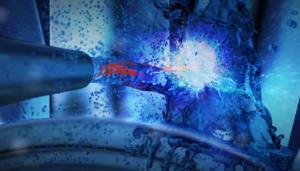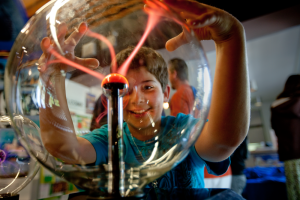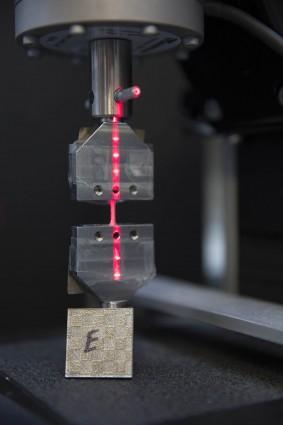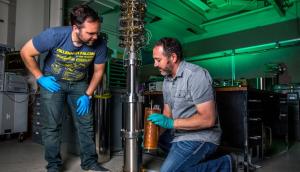LAB REPORT
Science and Technology Making Headlines
Oct. 5, 2018

Earlier this week, Strickland was named one of three scientists honored with the Nobel Prize for physics.
A star is born
Canadian scientist Donna Strickland calls herself a "laser jock."
The physics professor and former Lawrence Livermore scientist used the description in an interview with a Canadian newspaper, where she discussed efforts to get young people interested in the realm of physics.
Strickland has spent much of her life studying and teaching physics and describes her research as "fun." Now she shares the distinction of being one of three women to ever win the Nobel Prize for physics.


LLNL is using laser peening to improve the quality of 3D printed parts.
Peening for quality
LLNL and New Jersey metal finishing specialist Curtiss Wright Surface Technologies are exploring shot and laser peening as a potential post-processing method to improve the quality of 3D printed parts.
According to the team’s most recent findings, laser peening “is clearly shown to provide superior fatigue life and strength” in sample 3D printed parts.
Additionally, the ability to shape and/or correctively reshape AM components is explored with this method.


The Discovery Center in Livermore offers a number of interactive learning displays aimed at fostering curiosity and a better understanding of core scientific principles.
Take a vacation
Livermore’s close proximity to San Francisco and the Bay Area make it a popular weekend getaway destination.
One of the things you can do while there is visit the Lawrence Livermore National Laboratory Discovery Center. The center is aimed at encouraging curiosity and interest in science by offering hands-on interactive activities for children, while parents can learn all about the essential work in national security that is carried out at the national laboratory.
The Discovery Center offers science field trips for fifth graders on weekday mornings through the school year and is open to the public from 1-4 p.m. Tuesdays through Friday. If you would like to book a guided tour of the Laboratory, you need to do so well in advance of your visit.


Researchers say the ability to 3D print marine grade, low-carbon stainless steel (316L) could have widespread implications for industries such as aerospace, automotive and oil and gas.
In ship shape
From bioprinting blood vessels and using 3D printing to control reactive materials, to 3D printing nanoporous gold and researching metal 3D printing flaws, the scientists at Lawrence Livermore are well known for their impressive work with additive manufacturing.
LLNL researchers are using laser beam shaping to enhance properties during metal 3D printing. Specifically, they explored the use of spatial laser modulation to enhance the processability and properties of 3D printing metals. The team created a custom laser powder bed fusion (LPBF) test bed, which can produce single tracks of steel 316L (one of the most common forms of marine grade stainless steel) under various conditions.
In order to continue driving 3D printing from a rapid prototyping mindset to rapid manufacturing, it’s important to have in-depth knowledge of the AM process and the structures it can create. To do this, the LLNL researchers are working to develop a new science-based AM design strategy that can control thermal history by using tailored and simulation-driven light sources.


LLNL postdoc Nathan Woollett and LLNL staff scientist and ADMX co-spokesman Gianpaolo Carosi work on the cryostat system in which LLNL places its test microwave cavity. Photo by George Kitrinos/LLNL
A leap in the dark
It’s the biggest puzzle in science: We see only 5 percent of all matter and that makes up all the galaxies and stars, planets, black holes, quasars, pulsars, neutrinos — as well as humans and all other life on Earth. The rest is dark matter and there is an unending hunt for it.
One of the groups looking for dark matter comes from Lawrence Livermore, which is searching for axions -- low-mass particles -- that could solve one of the enduring mysteries of nature: what dark matter is made of.
It’s not that axions are a particularly new idea. First thought of in 1977, these particles are supposed to be much lighter than weakly interacting massive particles (WIMPs) but have been in and out of fashion for decades. But now, considering continuous nothingness from all the various WIMPs catchers, many scientists are considering axions their second-best bet.
The theory goes that the axion would interact with photons very weakly, but interact nonetheless. This is how the Axion Dark Matter Experiment (ADMX), housed at the Center for Experimental Nuclear Physics and Astrophysics at the University of Washington, is trying to catch them.
ADMX consists of a detector in a tank about four meters high. It feautres a very large superconducting magnet and a microwave cavity and works similar to a radio receiver. It’s like if the researchers had a radio that’s searching for a radio station, but they have no idea about its frequency — so they are turning the knob, slowly, trying to hear a signal when the frequency is just right.





